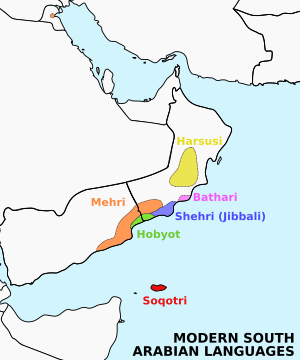Hobyót language facts for kids
Quick facts for kids Hobyót |
|
|---|---|
| Native to | Yemen, Oman |
| Native speakers | 200 (1998-2001)e19 |
| Language family | |
 |
|
Hobyót is a special Semitic language. It is spoken by fewer than 500 people. These speakers live in Eastern Yemen and Western Oman. Sadly, Hobyót could become an extinct language very soon. This means it might disappear forever if no one speaks it anymore.
Contents
What is the Hobyót Language?
Hobyót is part of a group called the Modern South Arabian languages. These languages are quite old and unique. They are different from the more common Arabic spoken in the region. Hobyót has its own special sounds and grammar rules.
How is Hobyót Different?
Every language has its own way of forming words and sentences. Hobyót has features that make it stand out. For example, it might have sounds not found in English. It also has a rich history tied to the ancient cultures of Southern Arabia.
Where Do People Speak Hobyót?
Hobyót is spoken in a very specific area. This area is near the border between Yemen and Oman. It is a region known for its rugged mountains and coastal areas. The people who speak Hobyót often live in small, traditional communities.
Hobyót in Yemen
In Yemen, Hobyót speakers are found in the eastern parts. This region is often remote. It is not always easy to reach. The communities there have kept their language alive for a long time.
Hobyót in Oman
Across the border in Oman, Hobyót is spoken in the western areas. These communities are also often isolated. This isolation has helped to preserve the language. However, it also makes it harder for the language to grow.
Who Speaks Hobyót Today?
The number of people who speak Hobyót is very small. Estimates suggest there are fewer than 500 speakers left. Many of these speakers are older people. Younger generations are often learning other languages.
The Hobyót Community
The people who speak Hobyót are often part of close-knit communities. They have their own traditions and ways of life. The language is an important part of their identity. It connects them to their ancestors and their history.
Why is Hobyót Endangered?
A language becomes endangered when fewer and fewer people speak it. Hobyót faces several challenges. These challenges make it hard for the language to survive.
Influence of Other Languages
One big reason is the influence of other languages. Arabic is widely spoken in Yemen and Oman. Younger people often learn Arabic for school and work. They might use Hobyót less and less.
Lack of Education in Hobyót
Hobyót is not usually taught in schools. Children learn in Arabic. This means they do not get formal education in their native language. This can lead to them using Hobyót less often.
Migration and Modern Life
Some Hobyót speakers move to bigger cities. In these cities, they might use Arabic more. This can cause them to lose touch with their language. Modern life changes can also affect traditional language use.
Efforts to Save Hobyót
Even though Hobyót is endangered, some people are working to save it. These efforts are important. They help keep the language alive for future generations.
Documenting the Language
Linguists, who are language scientists, study Hobyót. They record its words, grammar, and stories. This helps to create a written record of the language. This record can be used for teaching and research.
Raising Awareness
Raising awareness is also key. People need to know that Hobyót is special. They need to understand why it is important to protect it. This can encourage communities to use their language more.
Supporting Speakers
Supporting the communities that speak Hobyót is vital. This can involve helping them create learning materials. It can also mean encouraging younger people to learn and speak Hobyót. Every effort helps to keep this unique language from disappearing.

